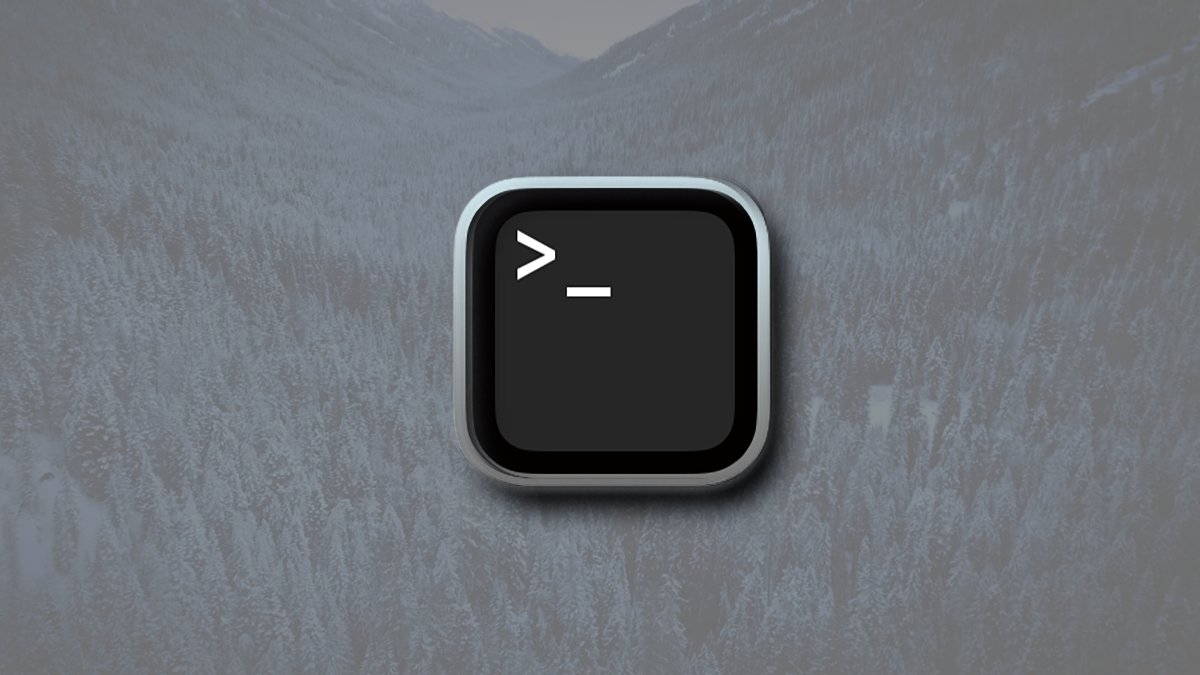AppleInsider · Kasper's Automated Slave
About
- Username
- AppleInsider
- Joined
- Visits
- 52
- Last Active
- Roles
- administrator
- Points
- 10,963
- Badges
- 1
- Posts
- 66,634
Reactions
-
How to measure your Mac's network performance with iPerf3 in Terminal
iperf3 is a network throughput tool used to measure the performance of the network your Mac is using. Here's how to use it in the macOS Terminal app.
iperf is a UNIX memory, network throughput, and bandwidth tool first developed "by the National Laboratory for Applied Networking Research (NLANR)". iPerf is a fully compatible rewrite of the older Test TCP (ttcp) app originally written at the US Army's Ballistic Research Lab for DARPA sometime around 1983.
There are also modern versions for Windows and Linux.
There are three major revisions of iPerf, and the third revision (iperf3) is not backward compatible with earlier versions. iperf3 was first released in 2014 and also includes a developer library so other programs can use it.
Unlike earlier versions, iperf3 is single-threaded whereas the earlier versions were multi-threaded. However, multi-threading was added in iperf3, version 3.16.
Multi-threading simply means more than one code path can run simultaneously on computers that have multiple CPUs or multi-core CPUs. Multi-threading is used in parallel processing and improves performance.
The iperf3 rewrite was undertaken by the US Dept. of Energy's Energy Sciences Network (ESnet) and Lawrence Berkeley National Lab in Berkeley, CA to improve performance. ESnet connects several research and commercial labs worldwide.
iperf3 source code can be found on GitHub at esnet / iperf.
The original iperf2 codebase written by Robert McMahon can be found on Sourceforge.
There is also a very detailed Iperf 2 & Iperf 3 Comparison Table at SourceForge.
Purpose
iperf3 is a memory-to-memory measurement tool, but it is commonly used to measure network and router performance, and even storage devices. Unlike iPerf2, version 3 also provides output in JSON format.
All iPerf variants require both a server and a client component for testing. iperf3 uses TCP and UDP (connection-less) protocols for testing and communication.
Although iperf3 is not backward compatible, iperf2 and iperf3 commands are very similar. ESnet has an iperf2/iperf3 command chart.
ESnet has a comparison chart which summarizes the option differences between tools. There is also a macOS tuning page which describes how to optimize your network and settings to use iperf3.
The main uses for iperf3 are to measure memory performance between systems, and network connections, bandwidth, disk performance, and throughput across networks.Installation on macOS
iperf3 is not included with macOS by default. The easiest way to install it is to use the Homebrew package manager and the Homebrew iperf3 formula.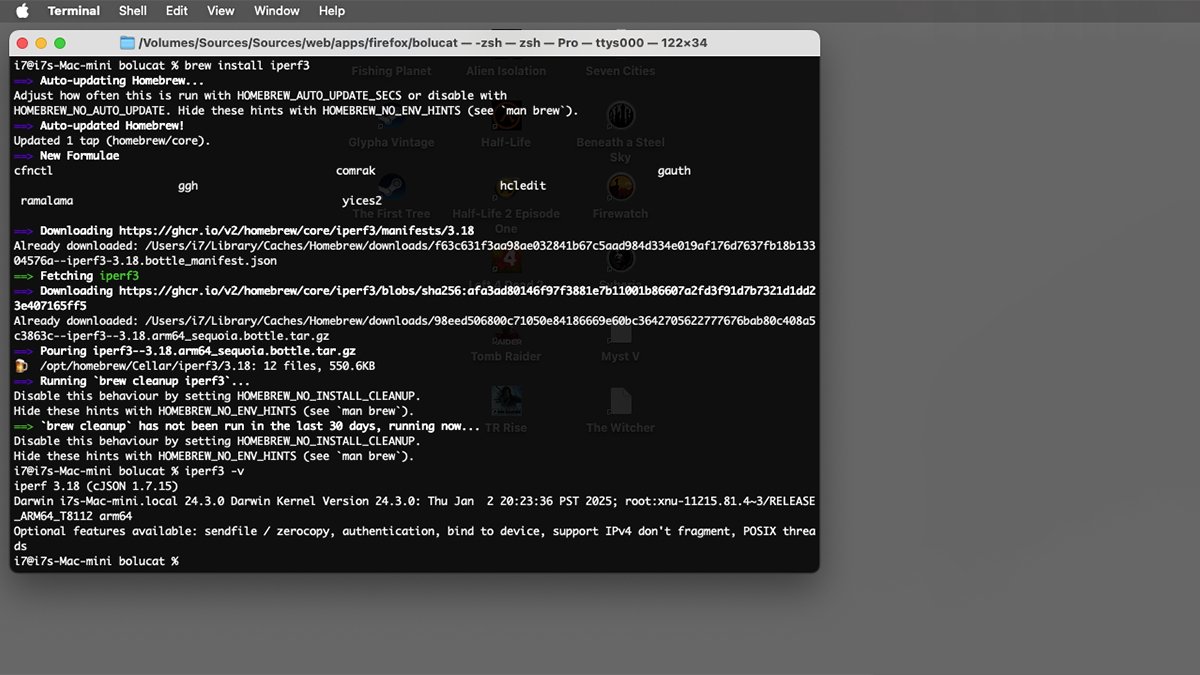
Installing iperf3 using Homebrew.
Once Homebrew is installed on your Mac, open Apple's Terminal app located on your Startup Disk in the /Applications folder and simply type:brew install iperf3and press Return on your keyboard.
The Homebrew implementation of iperf3 relies on several other Homebrew packages which will be installed automatically:- cfnctl
- comrak
- gauth
- ggh
- hcledit
- ramalama
- yices2
You can read about these on their respective Homebrew formula pages. You can check the installed version of iperf3 in Terminal with:iperf3 -vRunning iperf3 in Terminal
There are a wide array of options when running iperf3 in Terminal on macOS, but the simplest command is:iperf3 -c remotehost
where 'remotehost' is the IP address or name of the server you want to connect to. Remember, the iperf3 server component must be running and listening on the computer you're trying to connect to.
The-coption tells iperf3 to run in client mode and to connect to the specified server. To connect to the remote computer using UDP instead of TCP, use the-uoption along with-c:iperf3 -c -u remotehostAdditional options
There are dozens of other options including:- -p (port number)
- -f (speed label format)
- -i (interval in seconds)
- -B (bind to a specific network interface)
- -V (verbose output)
- -J (JSON output)
- -l (log file output)
- -d (debug mode)
- -h (show help)
If you are running your own iperf3 server, use the-sor -D (daemon) flag to start the server. When running in server mode there is also a--authorized-users-pathflag to set what users to allow.
By default, the iperf3 server listens on TCP port 5201 for connections from an iperf3 client. A different port can be specified using the-pflag followed by a space, then the port number. For example:iperf3 -s -p 5002
This command starts iperf3 in server mode and listens on UNIX port 5002 for incoming requests from clients.
You might want to use an alternate port instead of the standard port to create a private server. This can alsoo help secure your server against bad actors who regularly target standard server ports as a way to break into a machine.
For a complete list of iperf3 usage and options in Terminal use the man (manual) system:man iperf3followed by a Return on your keyboard.Terminal output
Once running, iperf3 will display test results in the Terminal with each test line showing the test interval (delay in seconds), amount of data, and overall throughput. To stop the tests press Command Z or q on your keyboard.
If you used the UDP (-u) option the tests will also show any packet loss.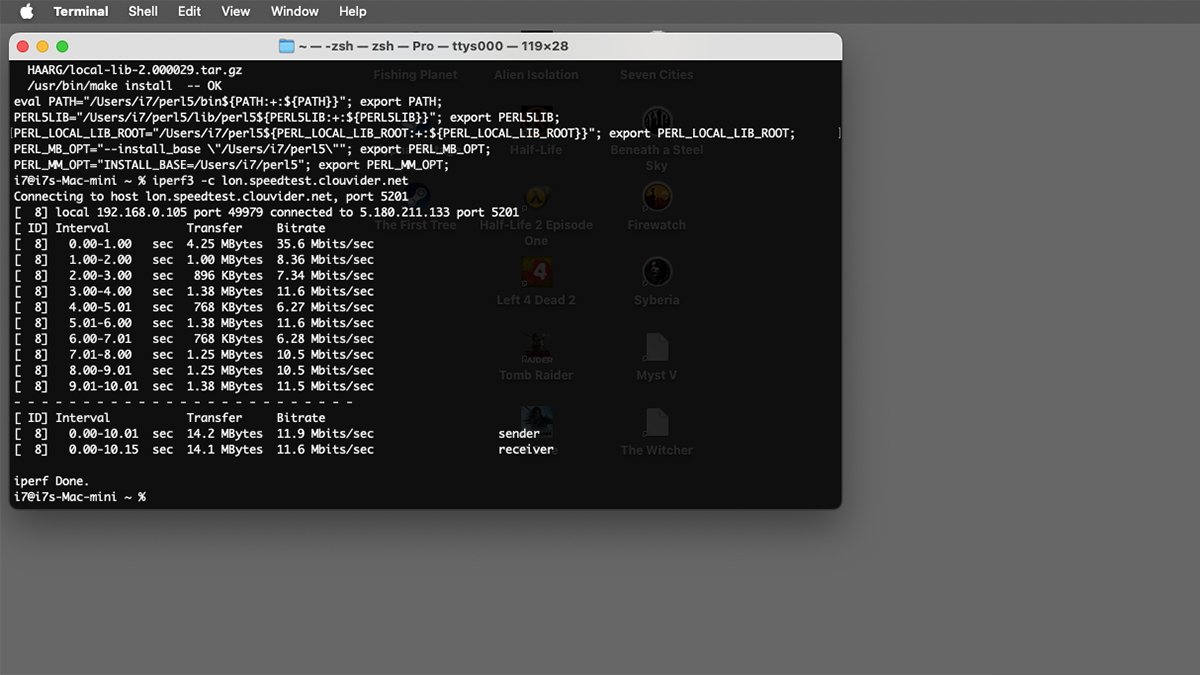
Running an iperf3 test in Terminal.
There is also an iperf3 Development page.
iperf.fr in France also has a lot of great info, including a list of test servers.
A dedicated list of free iperf3 test servers is available at iPerf3 Server List, but sometimes the load on the site is so great it's unreachable.
For another useful networking tool check out NetPipe.
iperf3 is simple to install and use (and is so easy to run) the next time you need a quick bandwidth test across a network you'll wonder how you got along without it.
Read on AppleInsider

-
ShiftCam SnapSeries roundup: a MagSafe photography ecosystem
The ShiftCam SnapSeries lineup has evolved to include a more powerful battery pack, a larger studio light, and a much taller tripod -- all connected via MagSafe. Here's how it all fits together.
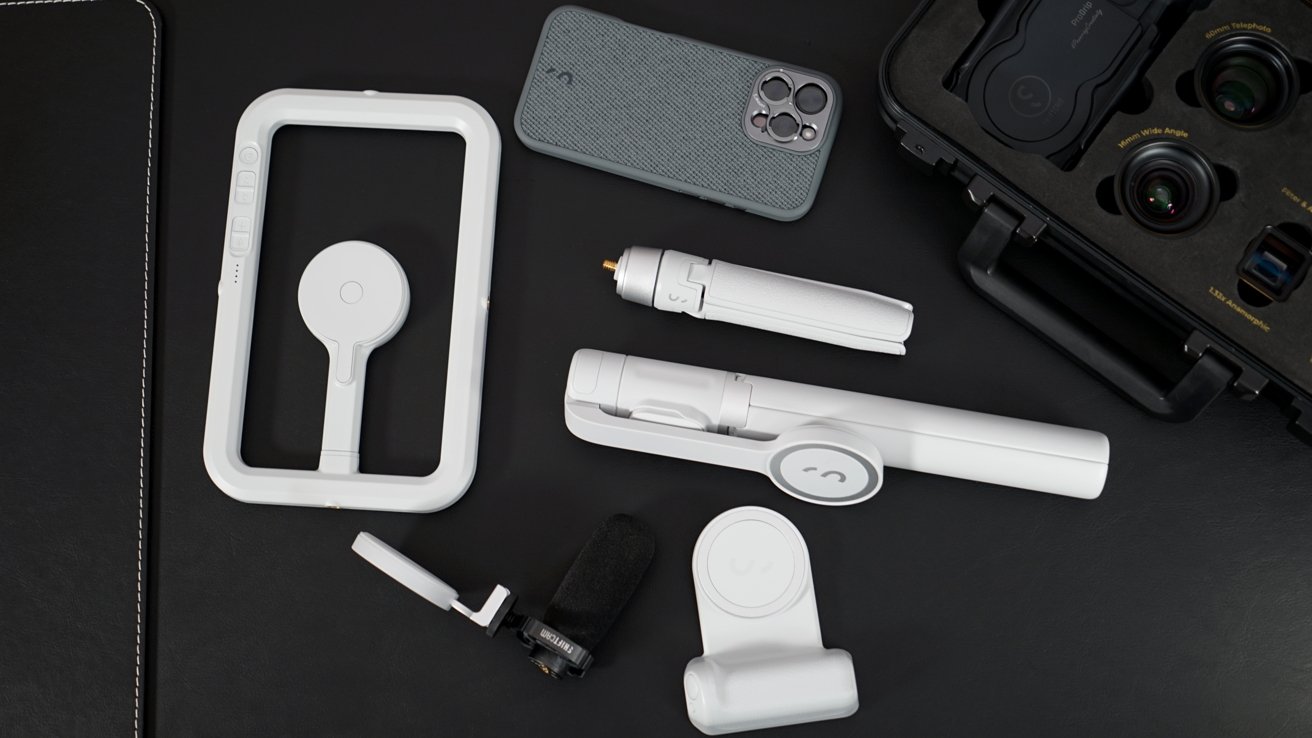
ShiftCam SnapSeries: expand iPhone photography with MagSafe
ShiftCam offers an increasingly varied range of equipment for content creators and photographers that work from iPhone. When I reviewed the original SnapGrip, I was excited by the prospect of an evolving MagSafe accessory ecosystem, and ShiftCam continues to deliver with the latest SnapSeries products.
ShiftCam also offers a lens set for iPhone called LensUltra, which I found to be a strong competitor to other attachable lens options. The iPhone 16 Pro Max is compatible with this set via a new case, so I'll discuss the set alongside SnapSeries here in this roundup.
There's a lot going on with ShiftCam and it seems the company is paying close attention to how people use their iPhone to create. The company has also introduced MagSafe SSDs that can snap into place alongside any SnapSeries accessory.
Everything snaps together with magnets, but you may not need or want everything, so here's how each accessory works and fits in with the rest.SnapGrip Pro
The SnapGrip Pro is a big update to the original model with a 5,000mAh capacity and Qi2. It's much more efficient and lets you capture photos and record video much longer.
SnapGrip Pro is a MagSafe battery pack and shutter control for iPhone
Connect directly to the USB-C port for 20W PD charging. It's much faster than Qi2 and handy when recording high-resolution video that's draining the battery quickly.
The SnapGrip Pro isn't just a MagSafe battery though, it's a Bluetooth shutter that can control the iPhone's camera. The grip is shaped like a traditional camera grip too, so it helps steady shots.
The iPhone 16 lineup has a dedicated button called Camera Control, but it's not quite the same as using SnapGrip Pro's shutter button. There are a lot of swiping and pressing gestures with Camera Control, which can be useful in some situations, but there's nothing better than an easy-to-press shutter.
Get a better grip while shooting photos and capture with less shake with SnapGrip Pro
I really like Camera Control, but I tend to use it while holding the iPhone with two hands. It's a bit fiddly too, so pressing the shutter can sometimes lead to accidentally zooming.
With SnapGrip Pro, you can easily hold the iPhone steady with one hand and press the shutter. It's really about what function you need, as I find both can exist and have their separate uses.
Get the SnapGrip Pro for $89 from ShiftCam's website.SnapStand Max
The 70-inch SnapStand Max is a great portable tripod that collapses to just 11 inches long and uses MagSafe to attach an iPhone. There is a built-in rechargeable shutter button that can be removed from the handle too.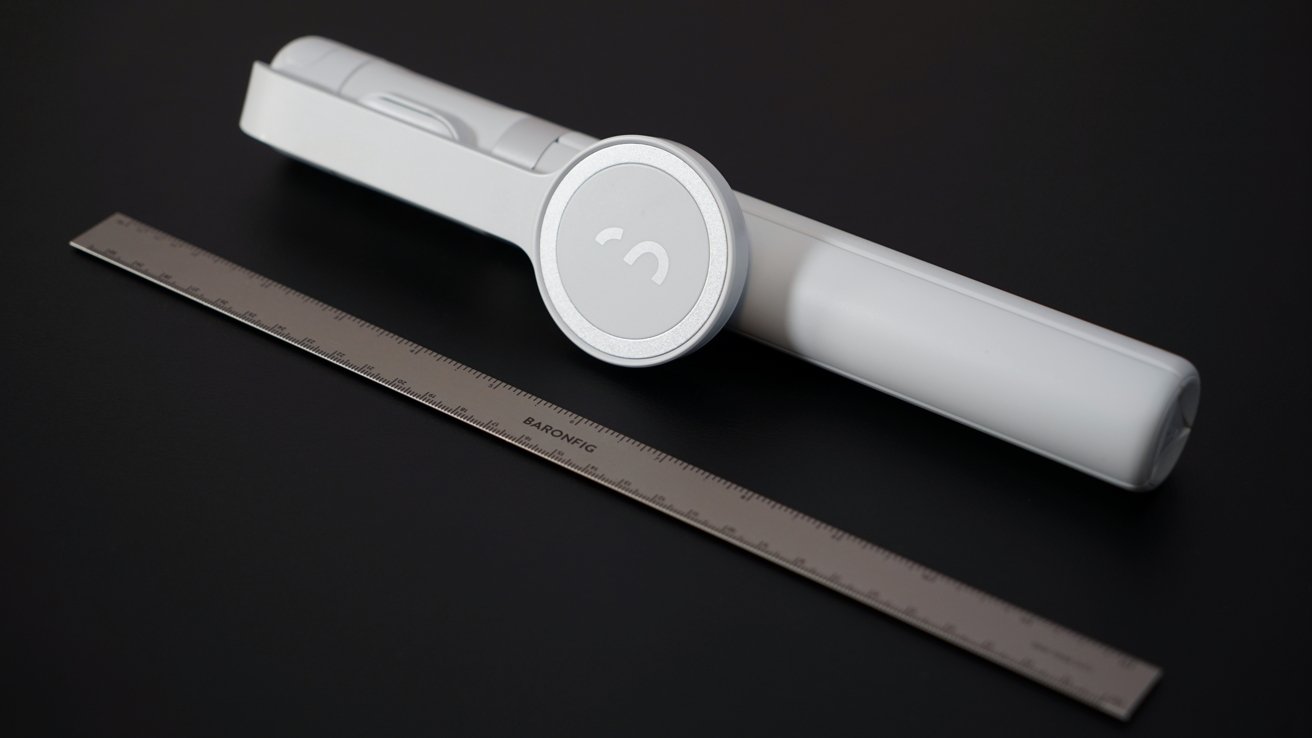
SnapStand Max folds up to fit in your bag
The MagSafe mount head can swivel 200 degrees for whatever angle you need. It's sturdy enough to hold your iPhone aloft without worrying about sag.
The stand opens with a button at the base of the handle when it's closed. It telescopes smoothly upwards and can be left at any length securely.
The mount still feels plenty sturdy even if you load it up with accessories like the SnapStudio Light, SnapGrip Pro, and an iPhone. However, be aware of how much weight there is as you extend the tripod, as an uneven surface could cause the entire device to tilt and fall.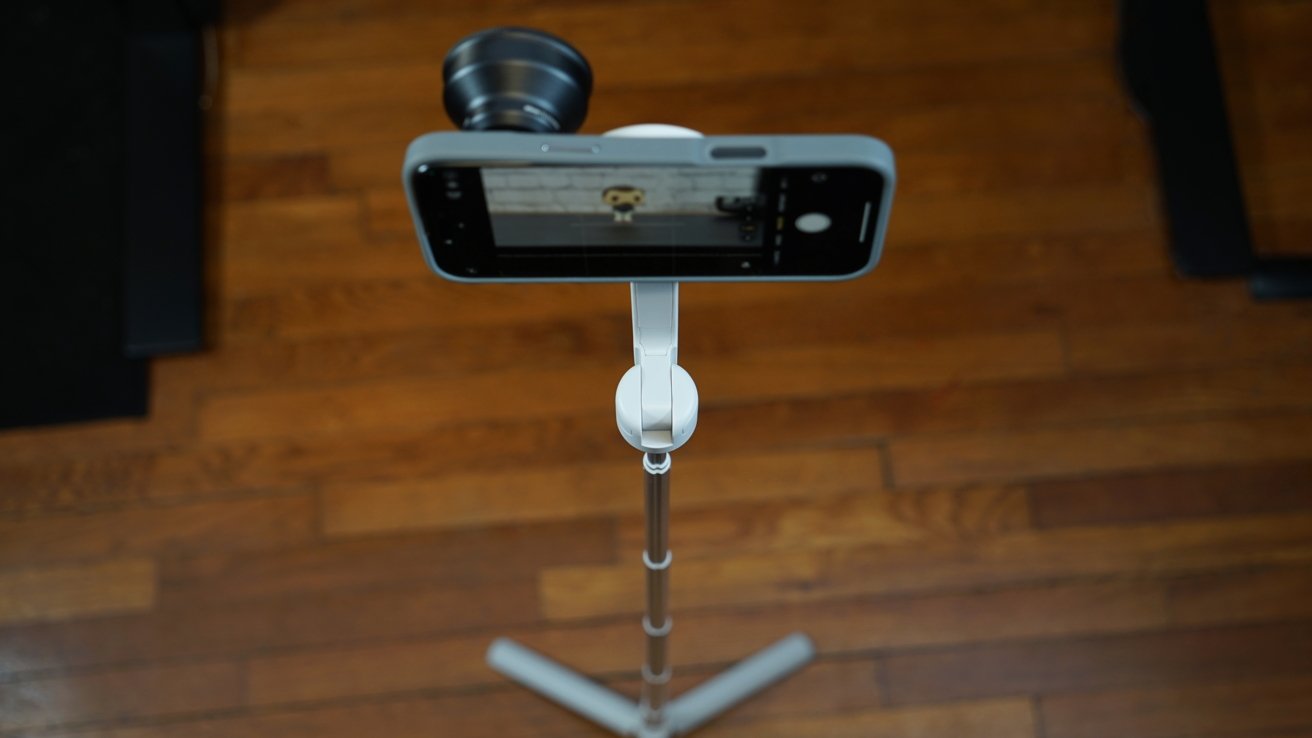
The full 70-inch height can get wobbly, especially with other accessories attached
When extending the SnapStand Max to its tallest setting, it may be best to limit it to the iPhone and SnapLight. It remains its sturdiest to about 48 inches in length -- any taller with more accessories attached, perhaps keep a person holding it steady.
I'm happy that the SnapStand Max can extend to such a tall height. It's handy for capturing a quick photo or video in some situations. However, that extra length comes at a tradeoff to stability and a slight bump can cause everything to fall over.
Even just setting it to 55 inches increased my confidence in its ability to stand without a wobble by a lot. Like any tall stand like this, it's important to understand its limits.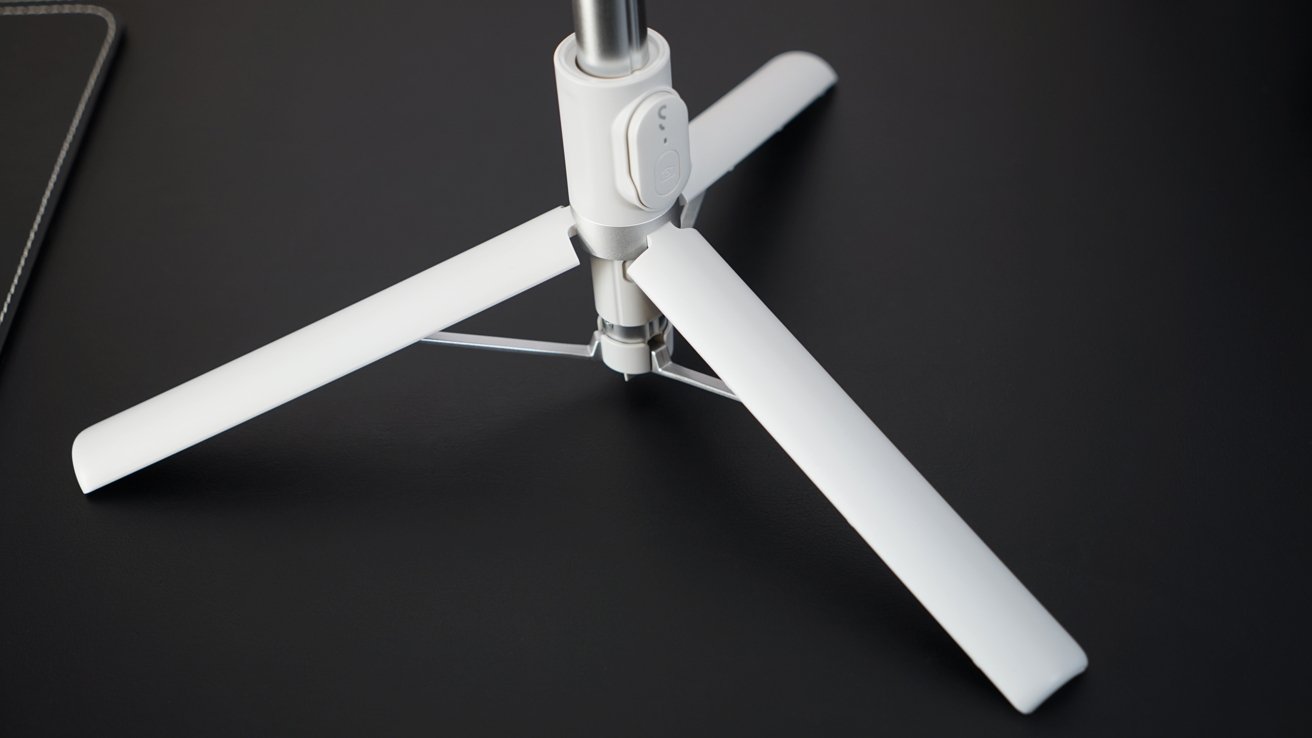
The collapsible feet don't do much to prevent tilting
The SnapStand Max isn't like a traditional tripod that has three legs that extend. Instead, it's got three feet that stay the same size while a neck is extended, which is automatically not as sturdy by design, but you do get a much smaller product when folded up.
All that said, I wouldn't ask for the stand to be shorter. Users just need to be careful and use their best judgement when setting up.
Get the SnapStand Max for $71.10 from ShiftCam, currently discounted from $79.SnapStudio Light
The SnapStudio Light is another battery-powered accessory from ShiftCam. It has 10 steps of brightness adjustment up to 440 lumens while on battery or 600 lumens when connected to a power source.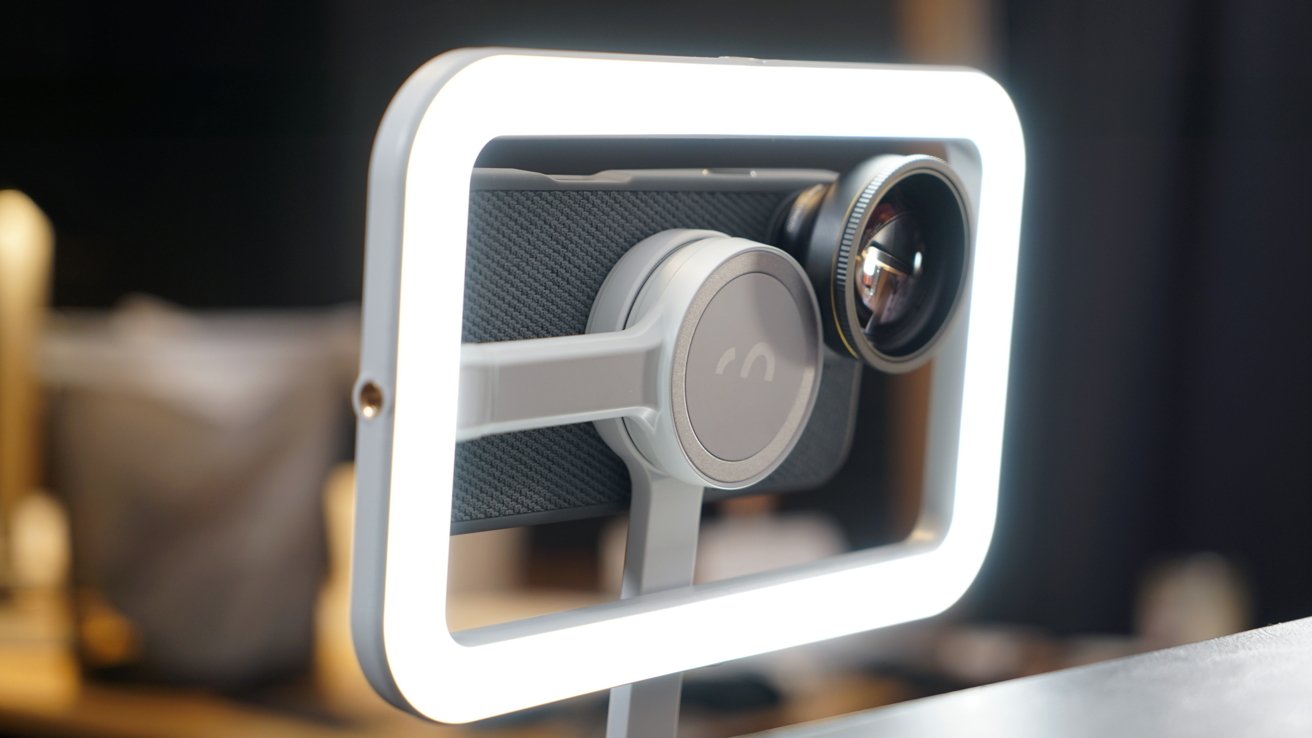
SnapStudio Light offers great lighting options for photos and video
Users can also control temperature 10 steps between 2,500K and 6,000K. Buttons on the side of the light provide easy access to controls.
The MagSafe mount in the center can be rotated 180 degrees for easy switching between front and back cameras. Attach it to the SnapStand Max for a studio setup, or connect it to the SnapGrip Pro for a portable selfie or vlogging tool.
Like with any ring light, reflections are going to be a problem, especially at a close proximity. You're going to see the square light in your glasses or even reflected in your eyes unless you're at a certain distance or angle from the light.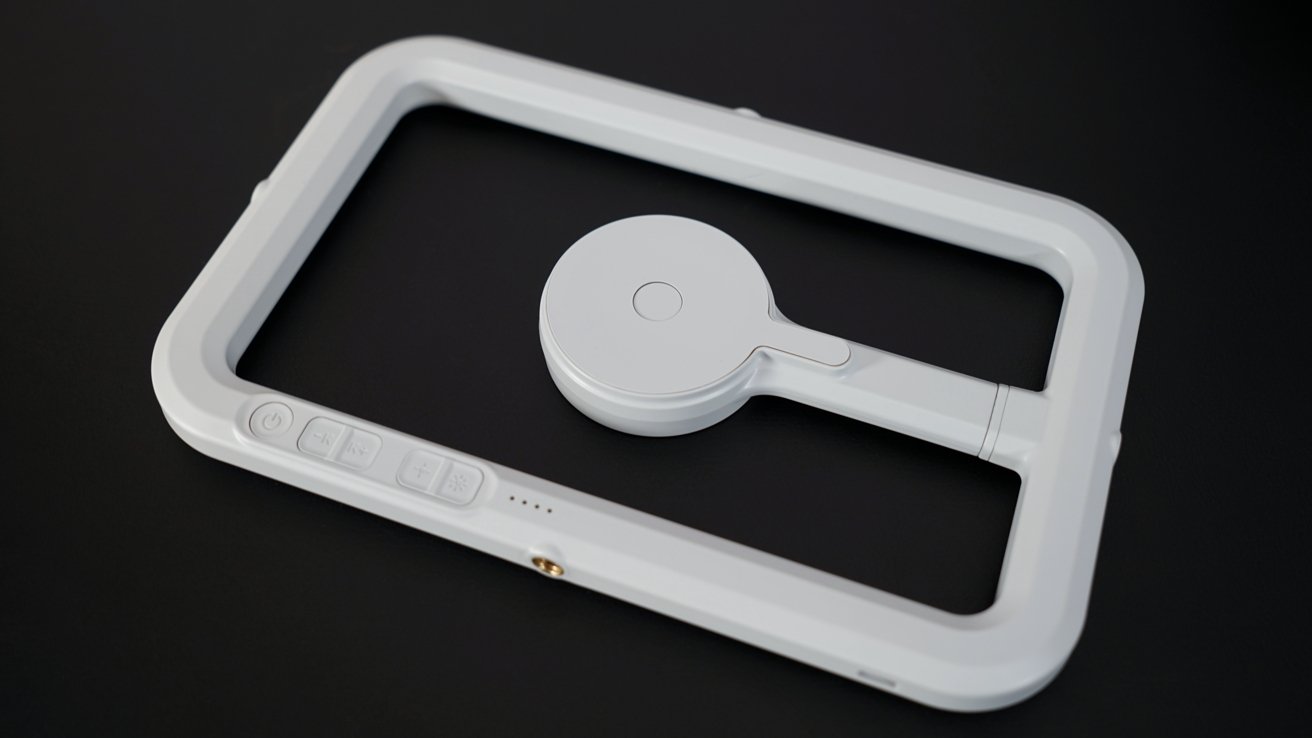
The SnapStudio Light has a center MagSafe mount that can be rotated
The nice thing about the ShiftCam ecosystem is all of the options for mounting devices. There's a screw mount on each side that can attach to the included stand or any standard tripod mount.
The internal battery can last about 40 minutes at max brightness. Connect the SnapGrip Pro and wire it to the light to extend its time and available brightness.
Get the SnapStudio Light for $89 from ShiftCam.ProMic Shotgun and Cold Shoe Mount
If you're looking to add a little more versatility and universal compatibility, ShiftCam has a cold shoe mount called the SnapShoe. It's only $29.99 from ShiftCam.
The ProMic Shotgun attaches to the MagSafe SnapShoe mount
If you buy the ShiftCam ProMic Shotgun, it can be set into the SnapShoe. Buy them as a bundle for $109.98 or get the mic alone for $79.99.
The SnapShoe is a great addition because it attaches via MagSafe but allows other accessories outside of the ShiftCam ecosystem to be attached. It's just a standard cold shoe mount, so bring whatever light or mic you'd like.
The ProMic Shotgun does a great job picking up your voice, and it's going to be better than your iPhone mic in some situations. That's especially true since you have the options for different wind filters.
It's a Super-cardioid mic with a 20Hz to 18kHz frequency response. It works over a standard audio jack and has a second port for connecting headphones.
ProMic Shotgun relies on audio jacks for interfacing
You're going to need a USB-C to headphone jack adapter to use this mic, so it's probably not the best choice for modern iPhones. Though, if that's not an issue, then it's a good mic.
Perhaps ShiftCam can work on releasing a new version with USB-C connectivity.SnapMount Camera Case
ShiftCam let me try out its SnapMount Camera Case in addition to its SnapSeries accessories. It's part of a complete photography or media production package, so I had to put it all together with the LensUltra set.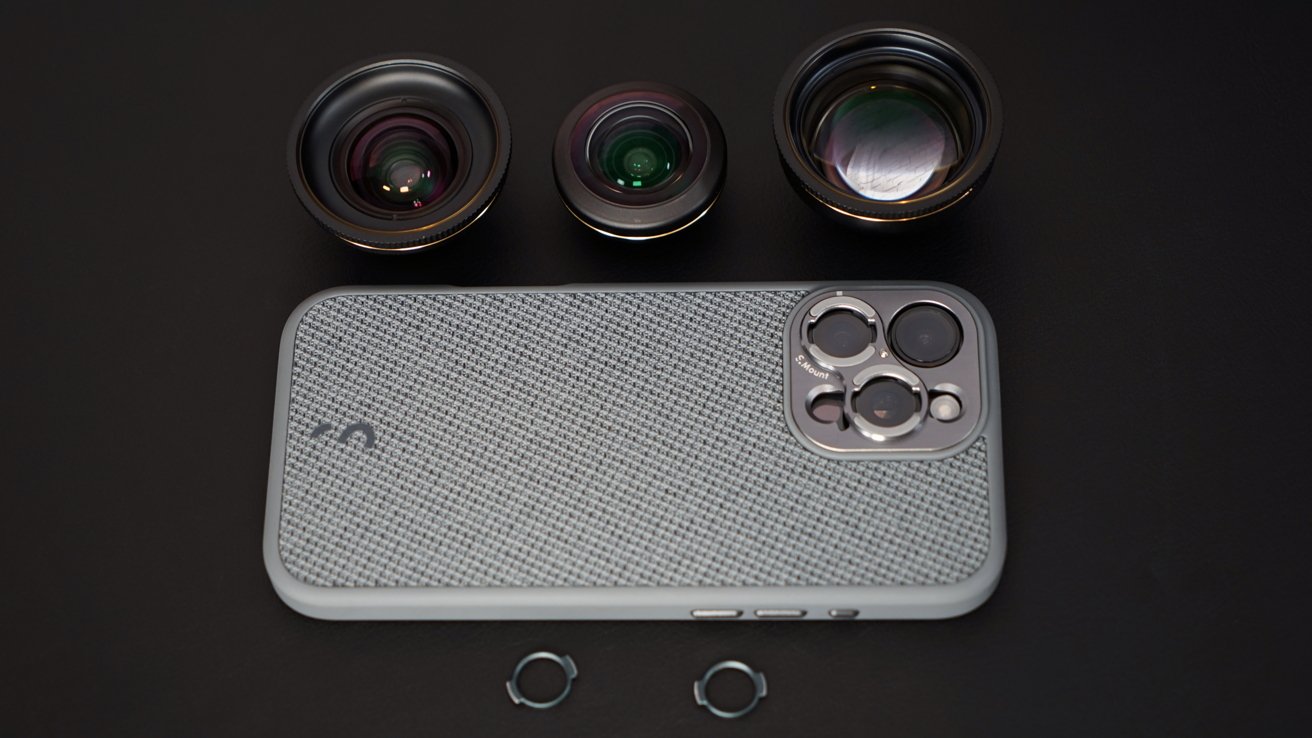
SnapMount Camera Case with adapters bring LensUltra to iPhone 16 Pro Max
The new case is made from a really nice textured fabric that's actually machine washable. It has a cutout for Camera Control and tactile covers for the other buttons.
The lens mounting system changed to something ShiftCam calls an S-mount. It was previously a 12mm thread, so this change is a bit odd considering the LensUltra system still uses that older thread style.
I assume it's due to a shift in how they want to make lenses in the future. The 12mm mount requires a couple of turns to secure the lens completely, while the S-mount is just a simple twist mechanism that feels secure with a half turn.
The SnapMount Camera Case comes with two S-Mount adapters
The SnapMount Camera Case ships with two of the S-mount adapters, so that should be enough for users to get by. However, for someone like me that owns the full lens set, I wish I could order more S-mount adapters separately just so I didn't have to swap the mount between lenses.
The case supports MagSafe charging and works with all the SnapSeries accessories without issue. I like that the case has a nice design and isn't too bulky, so it can be used as a case regularly without feeling like I need to take it off when not using the lenses.
Get the SnapMount Camera Case for $49.99 from ShiftCam. Be sure to choose your iPhone model from the list.Using SnapSeries
If you get the SnapSeries Professional Kit and the other accessories mentioned above, they can fit together in interesting ways to accomplish different tasks. Of course, you can snap them all together into a kind of monster MagSafe tower, but it's likely not very practical.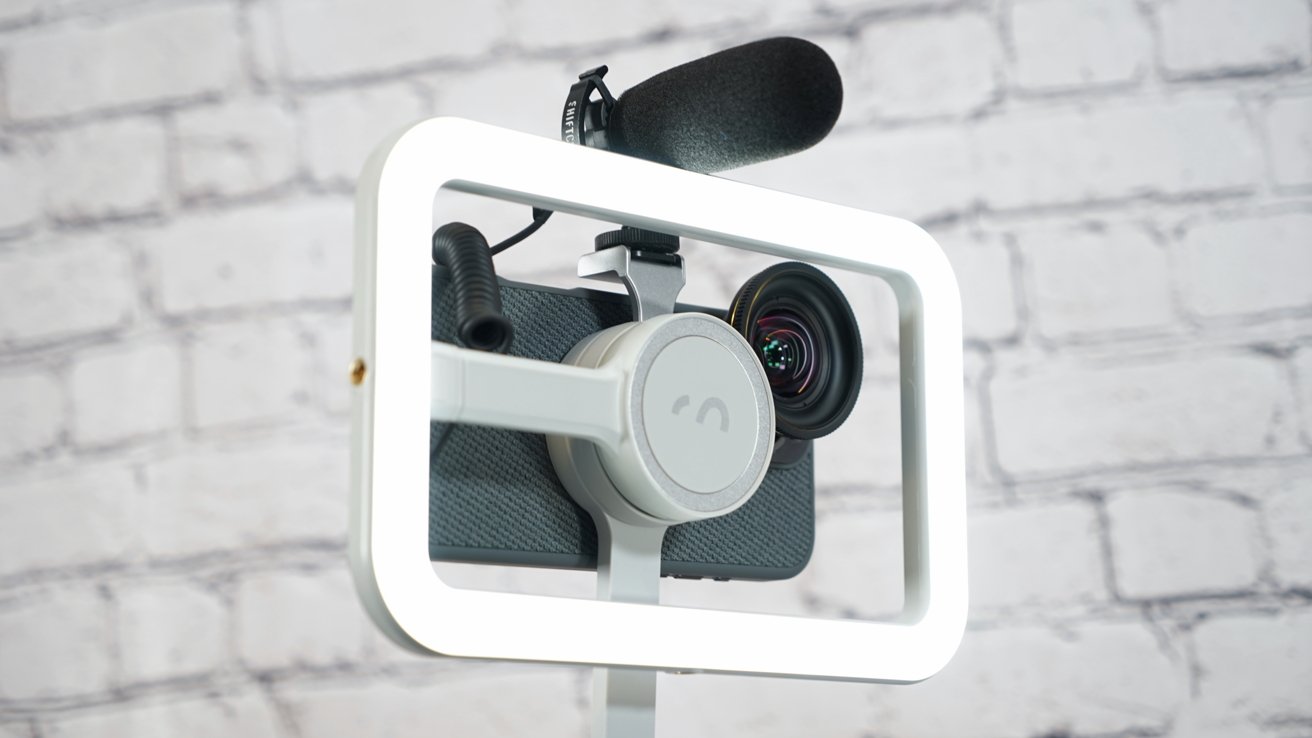
ShiftCam SnapSeries can be used together for a modular setup
Set up to record a video with the stand, light, and microphone, and since you're likely stationary, use an external power source instead of attaching the MagSafe battery to the already wobbly stack. Use the battery pack when you're looking to go handheld rather than relying on the stand.
That isn't to say you can't connect everything together, but it's just a little unwieldy. As I've said previously, use your best judgement.
I do think it's really cool that you can pick and choose accessories to snap together for whatever you need at that moment. However, there may be some trial and error in figuring out exactly which order the pieces should go in.
The only way the SnapGrip Pro charges the iPhone is if it is directly attached, but there are situations where you'd want it anyway. For example, place the iPhone in the SnapStudio Light then attach the SnapGrip Pro so you have a grip with a shutter button for taking well-lit selfies.
Take better selfies with SnapGrip Pro and SnapStudio Light
Take that setup even further by using a USB-C cable to provide power and increase the SnapStudio Light brightness, or charge the iPhone over cable at 20W.
There are lots of ways to use the SnapSeries magnetic accessories. The kits are the best way to get everything you need, but be warned, you'll likely keep coming back for more from ShiftCam to improve the versatility of the setup.
Get the SnapSeries Professional Kit with the SnapStudio Light, SnapStand Max, and SnapGrip Pro for $231.30 from ShiftCam, a 10% discount available at publication. The SnapSeries Professional Kit Pro includes everything plus the ProMic Shotgun and SnapShoe for $311.93, also discounted by 10%.
Read on AppleInsider


-
25 years of Apple's innovation with the iTunes Music Store
The fourth of Apple's top 10 major areas of innovation in the last 25 years is 2003's iTunes Music Store. Here's how Apple transformed the music industry and created an entirely new digital media marketplace.

25 years of Apple Innovation -- iTunes Music Store
The first segment discussed Apple's 2000 release of Mac OS X Public Beta, its first important area of innovation in the last 25 years. The second segment focused on Apple's reinvented retail operations. The third segment introduced iPod. The fourth details how Apple brought retail to digital media within iTunes.
"Innovation" brings to mind the explosive new creations of the iMac, iPod and iPhone. But the greatest potential opportunity for change can also come from a devastating destruction of the status quo, paving the way for something really new.
By the year 2000, the foundations of the enormous 20th Century recording industry had been fatally struck by file sharing. Over the next 25 years of the new millennium, Apple tasked itself with a global rebuilding of the music industry. The alternatives could have been terrible.
The commercial lifeblood of all cultural expression from studios and theater, animated by decades of work devoted to licensing and performing rights and infused with everything that perpetuated the existence of Old Media, had been blind-sighted in the late 90s by the sudden impact of the digital Internet.
The vast global business of CD sales was effectively left for dead as an enormous roadkill on the information super highway. Rapid advances in bandwidth and processing speeds in the late 90s suddenly turned the CD from a physical media into a stream of bits that could be duplicated and rebroadcast anywhere, effortlessly.
The collapse of the initial internet bubble "dot com" economy, starting in 2000, helped to deflect some panic away from the music industry, but the reality was clear: the CD sales that had been inflating the music industry were now leaking air with the violence of the Hindenburg.
CDs sales hit a $22 billion peak in 1999 just as Napster file sharing, burnable CD-Rs and new trend towards mobility opened up alongside iPod.
Suddenly the global music industry was facing a crisis similar to the one Apple itself had experienced in the 90s. If anyone can copy all of your work, without paying you anything, you've got nothing.
When Microsoft stole the core foundations of the Macintosh, Apple had to scramble together a new newer, better Mac experience to fight for a right to exist. Now that everyone had free rein to copy and paste digital music, the industry had to figure out how to create and sell a new digital experience.
They were unable to figure this out on their own. Sony, which had helped build recording hardware with its iconic Walkman, had also delved into the software business. It was making the memory and processors and recordable optical technologies that were imperiling the same recording business it now owned.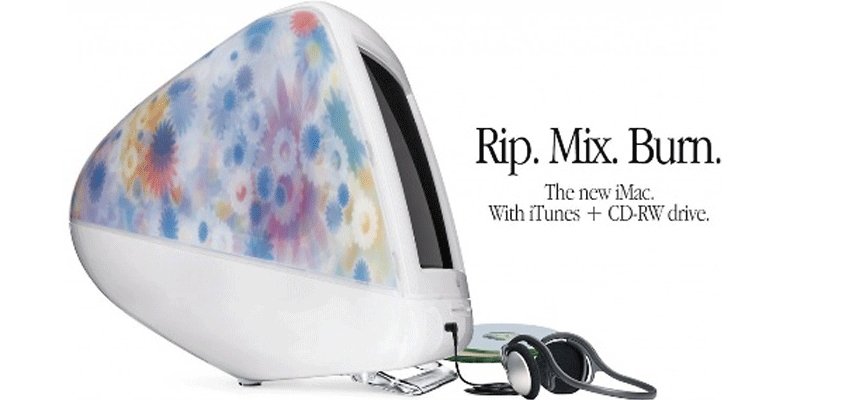
Sony attempted to create a new MiniDisc format that would use its ATRAC DRM security to prevent buyers from ripping and mixing their own music. It hoped to use its ATRAC music format to enable a digitized version of CD sales that could work across PCs and music devices, but couldn't quite pull things together.
In fact, much of the music industry was seeking to find a simple replacement for CDs that could hold back the tide of permissive file sharing with some sort of encryption. They hoped to get right back to selling increasingly expensive albums with just one or two hit songs, as they had been for years.
Microsoft similarly pursued its own Windows Media DRM, seeking to tie digital rights management to Windows. The music labels desperately needed some solution, but didn't want to hand over control to an existing monopolist either.
That made Apple an attractive alternative. The fledgling return of Apple, its new Mac OS X alternative platform and its experience in digital media with QuickTime all helped create a viable third option that promised a better experience for users, contained within the sandbox of Apple's higher end customers.
Steve Jobs negotiated deals with the existing five major recording labels, Universal, Sony, Warner, EMI and BMG, which allowed Mac users access to buy 99 cent songs and $9.99 albums using Apple's simple FairPlay DRM in the new iTunes Music Store in the spring of 2003.
Apple's new iPod and iTunes-equipped Macs had been enabling users to listen to music from their own CDs as well as songs distributed as MP3 files. The new iTunes Music Store created a legal marketplace to allow buyers to browse and download new music, and pay for each track individually.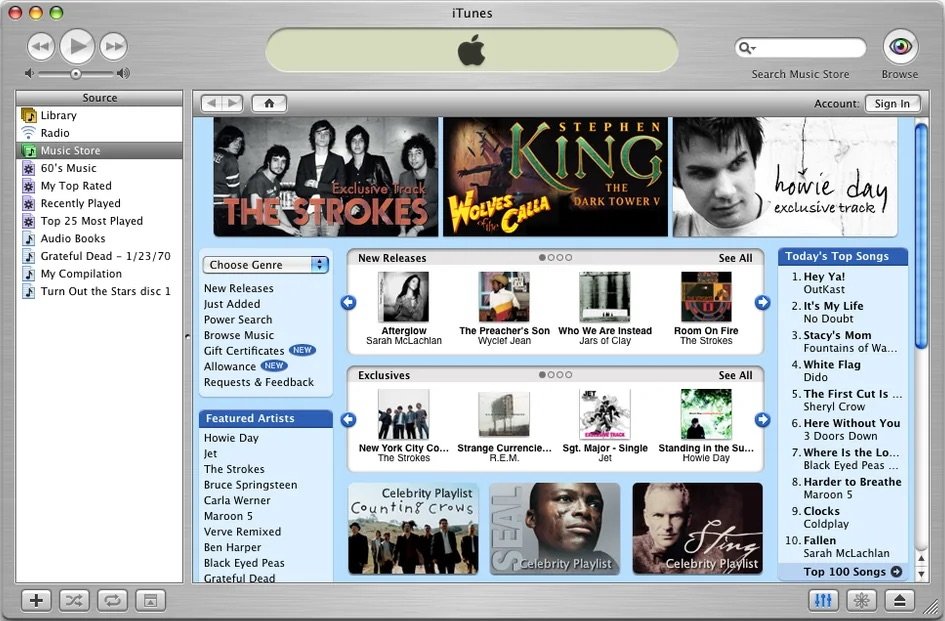
iTunes 4 introduced the iTunes Music Store
While iTunes couldn't change the fact that Napster, Kazaa and other "free" sharing platforms existed, it did create a functional, easy to use retail experience as welcoming as Apple's own retail stores created to sell Macs and iPods.Cut from the same cloth
Apple had just raced to assemble its own direct retail Mac efforts online in 1997-- using the WebObjects technology it had acquired from NeXT-- giving itself the ability to reach hardware buyers and customize an online buying experience right in their web browser.
Apple now wanted to expand the concept of a digital storefront from selling hardware to selling software. And it wanted to integrate the store right into iTunes.
Part of the work to deliver the iTunes Music Store came from Apple's parallel efforts to adapt an open source web browser: the KHTML-based Safari, first released in 2003.
Microsoft's Internet Explorer and Mozilla's Gecko were both bloated and slow, so Apple began working with KDE's rendering engine to create a modern, streamlined new web rendering system that could be deployed as both the Safari web browser, an embedded into iTunes as WebKit.
Within iTunes, WebKit could be used to create a secure, dynamic store for new digital content, starting with recorded music.
By focusing on what users wanted and delivering an easy to use catalog of downloadable music, Apple not only secured itself a supply of commercial music for its Mac and iPod users, but also created the foundations for selling and renting films, music videos, iTunes Extras and eventually iPod games.Caught flatfooted
Microsoft and Sony had been trying to build castles that could control the distribution of digital goods, but their efforts failed because they didn't focus on the experience of users.
Microsoft promoted Windows Media DRM as "PlaysForSure" across the industry as a broadly licensed initiative in the same manner as Windows. Sony tried to sell a tightly integrated experience that required its own formats.
Apple responded to what its audience wanted, and delivered innovations to delight them. In 2005, Apple appeared onstage with Motorola's ROKR E1 iTunes phone, which brought iTunes integration to other devices. But then Apple focused on its own new iPod nano at the same event, occupying space in the mobile world while expanding its music presence.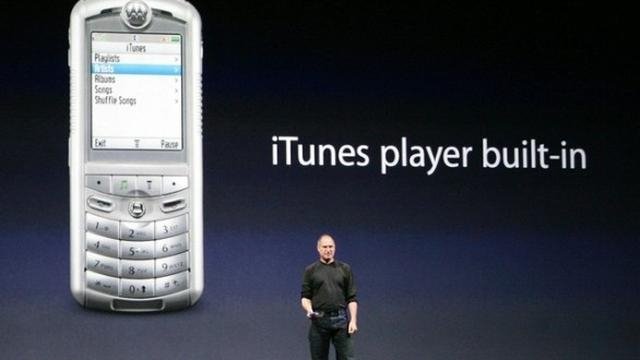
iTunes came to mobile but Apple remained focused on iPods
Apple was also promoting digital connectivity with mobile phones with contacts and calendar synching, just as it had been with iPods. It was again laying the foundations of the mobile future while remaining focused on what it was presently selling. Until 2007, that was iPods. But the groundwork for a full mobile desktop device running apps like the Mac was coming together.
Other companies were already pursuing the concept of selling mobile software online. Palm opened its Pilot PDA software store in 1997, and tried to build an ecosystem of digital app sales. Piracy and security issues resulted in an uncertain market for developers, who had to charge significant fees for their apps to recoup their investment. Most of their apps would end up being copied around like Napster's music file sharing.
Windows Mobile also tried to operate a software marketplace selling smartphone titles, along with Nokia's Symbian platform and Sun's Java ME, but developing and distributing apps proved to be as difficult for mobile players as music was for the labels. Nothing was catching on anywhere, and it looked like software markets were in as bad of shape as the prospects for legal music and movie downloads.
Apple's open invitation within iTunes to access your own music and also purchase tracks via its Music Store resulted in rapidly growing economy of scale that expanded into TV and movie downloads in 2005.Firing on all cylinders
Apple introduced iPod Video in 2005, along with a new Video Store in iTunes offering a limited selection of TV shows priced at $1.99. Building upon iTunes success in music sales, the slow introduction of paid video downloads began with "standard definition" videos that could play within iTunes, on a video iPod, or later on Apple TV.
Apple embraced the concept of subscribed content feeds for mobile users, adopting the name Podcasts after its music player. It added automatic downloads and distribution within iTunes.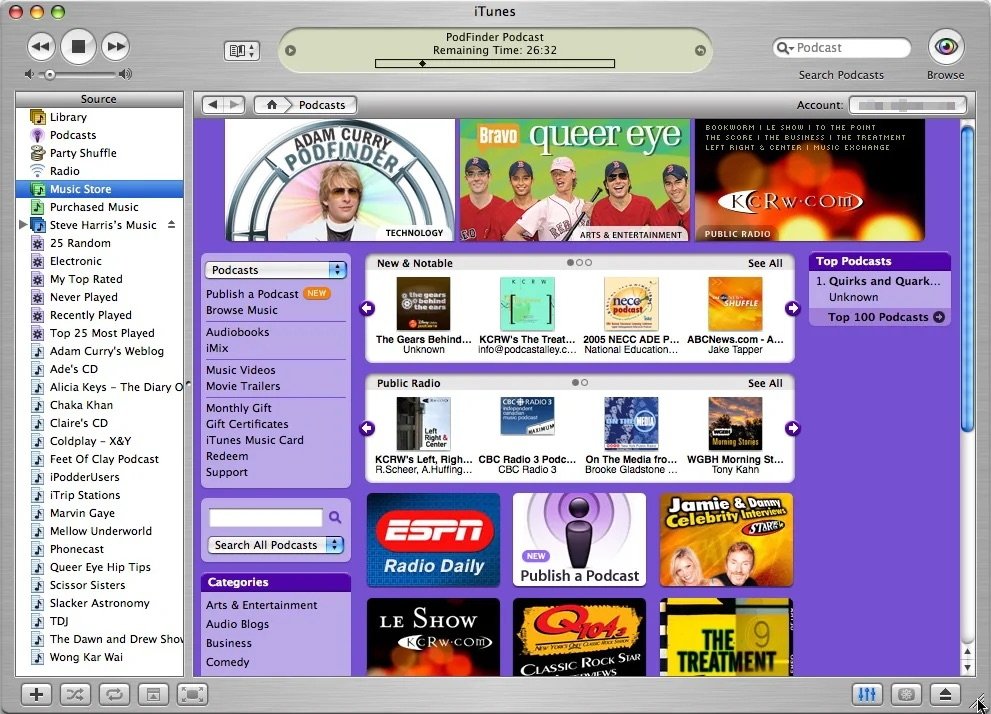
Podcasts in iTunes 4.9
The following year Apple released a selection of $4.99 iPod Games, ranging from its own Texas Holdem to titles like Bejeweled, PacMan, Tetris and Mahjong from partners. Apple was making rapid progress in not only building the tools to develop mobile games, but also in building the infrastructure to distribute and market them.
Apple's work with iTunes was also supporting its development of its Safari web browser and embedded online stores, building the foundations for its subsequent launch of the iPhone and its App Store. iTunes and the iPod would ultimately become components of the iPhone itself, serving as the "wide screen iPod" feature tied to its phone and internet communicator trio of defining elements.An evolving digital content platform
Apple's efforts to develop a retail marketplace for digital content created the model for not just the App Store, but also the company's further expansions into media with Apple Music in 2015 and Apple TV+ in 2019.
Along the way, Apple increasingly worked to make iTunes Music higher quality and more flexible for users. In 2004 it introduced ALAC (Apple Lossless Audio Codec) for high-quality audio without compression. It introduced iTunes Plus In 2007, which offered higher-quality, DRM-free music at a premium price, doubling the bitrate to 256 kbps AAC.
In 2008 Apple released Safari 3.1 with support for HTML5, enabling native media playback on the web without plugins. It focused on the future of digital media with H.264 and H.265 video, moving beyond the world formally tied to Flash. Other media codecs were replaced with web standards as QuickTime Player 10 was introduced the following year. In 2011 Apple introduced AV Foundation in macOS (10.7) Lion and iOS 4 as a modern framework for handling audio and video.
In 2012 Apple introduced Mastered for iTunes, a higher quality format that starts with 24-bit, 96 kHz masters instead of standard "CD-quality" 16-bit, 44.1 kHz audio. Using Apple's own AAC encoder, it produces 256 kbps AAC audio that sounds virtually lossless, preserving more detail and dynamic range from the original studio recordings.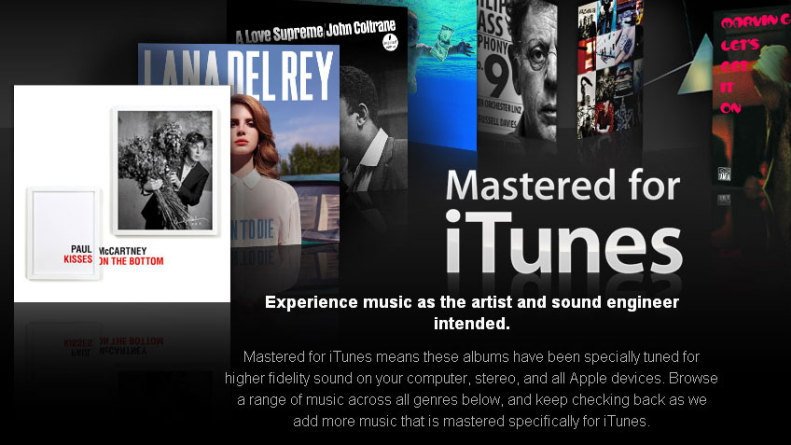
In 2019 Apple's bespoke mastering was rebranded as Apple Digital Masters. Having such tight integration with recording studios already, Apple was in a unique position to introduce a new level of sound quality in 2021: Spatial Audio. This similarly required specialized track mixing by the studios. It effectively created a 3D soundscape that could be reproduced by speakers or headphones.
Support for Apple Digital Masters, Lossless Audio, and Spatial Audio were included at no additional cost in Apple Music, setting the service apart as providing far higher quality than rival services like Spotify, while also providing a unique feature for Apple to include in its sound hardware.
Spatial Audio also paved the way for creating Immersive Video with Spatial Audio on the new Vision Pro, creating a fully surround-immersive experience using familiar tools.
Apple's relentless efforts to innovate in music and in the sales of digital media have given the iTunes Music Store an incredible legacy of industry firsts that have changed the entire nature of the content business-- one that Apple now directly participates in as a content producer for Apple TV+ and the Vision Pro App Store.Surviving the social media storm
The original impact of the iTunes Music Store was closely tied to the explosive growth of iPods. It helped create fertile grounds for launching iPhone and its own App Store market for mobile apps. But it was also forced to adapt and change as new technologies and emerged outside the company.
Apple initially worked with Facebook to build a social media component into iTunes. After a dispute over access to user data, Apple launched its own social features for iTunes 10 in 2010 as Ping.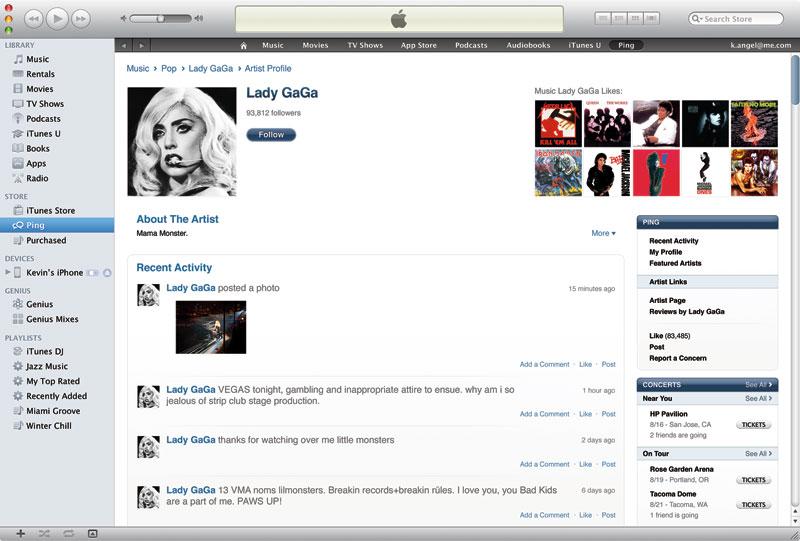
Ping imagined a social component for users to interact with musicians
Facebook not only backed out of partnering with Ping, but also withheld its Facebook app from the new iPad, hoping to throw its support behind tablet rivals. Apple's solo efforts with Ping were troubled by spam and the problems of trying to moderate an online public space.
Apple abandoned Ping and instead explored efforts to integrate directly with Twitter and Facebook in iOS 5 and 6 in 2011-2012. At the same time, Apple began work on iCloud to deliver its own suite of online services without a social component.
Apple increasingly pursued a closer, direct relationship with its customers rather than trying to connect them together into a social grid. This direction led Apple into promoting security and privacy rather than wide, permissive sharing of data and acting as an intermediary that siphoned off collected data for marketing purposes.
Other big industry players took the opposite path. Facebook worked with Android licensees to deliver an experience centered around Facebook. The 2013 HTC First put Facebook photos on its cover screen and tried to keep users locked inside the world of Facebook and Messages.
Facebook Home imagined a phone centered around Facebook rather than apps
Facebook's phone failed, its tablet partnerships failed, and its repeated subsequent efforts to snub Apple and push Facebook as the home page of mobiles failed. Apple eventually pulled the plug on Facebook integration in iOS 11 in 2017, leaving Facebook and other social media networks as standalone apps on an otherwise privacy centric platform.
Google tried to buy its way into social media with Orkut, then integrated Buzz into Gmail in 2010 and launched the Facebook-like Google+ the next year. Google not only failed at launching its own social media efforts, but also failed to push its own devices as compelling mobile alternatives tied to advertising, at least outside of low end, high volume "carrier friendly, good enough" Android devices sold by licensees.
Apple ended up winning in social media by choosing not the play in the surveillance advertising market. Instead, it build a reputation as the choice for privacy and data security, which became increasingly more attractive as the public began to understand how social media networks and advertisers were using their data, making them the product to be sold to advertisers.iTunes at Home
Across the 2010's Apple also introduced deeper integrations between iTunes and the home. It relaunched its AirTunes wireless music streaming to speakers as AirPlay in 2010, adding new support for video and screen mirroring. The iTunes Music Store also expanded into TV and movie sales and brought content to Apple TV, which slowly grew as a media center for watching iTunes content on your TV.
Despite longstanding rumors that Apple might launch its own TV set, the company instead "pulled the string" to see where things were going with an incremental rollout of Apple TV devices that brought higher quality videos and rental options into the home.
Despite many cheaper, ad-centric offerings, Apple TV continued to gain in popularity as an iTunes Store for your TV through the 2018 introduction of AirPlay 2, which brought multi room streaming to Apple's products, and licensed the protocol to other TV and speaker makers. AirPlay 2 was broadly adopted by TV makers as a high quality, flexible streaming option catering to iPhone users.
Cindy Lin, director of program management, demonstrates the new Apple TV app
The next year, Apple followed suit with licensing its Apple TV app to other TV makers. Since 2020, Apple has spread Apple TV as an app across platforms ranging from Roku, Amazon Fire TV, PlayStation, Xbox, Google TV and Android TV, acting as the modern equivalent to the iTunes Music Store of the last decade.
In this market, rather than building all the TV hardware, Apple has pursued making the content to play on them with Apple TV+ and its various partnerships to deliver content through its store.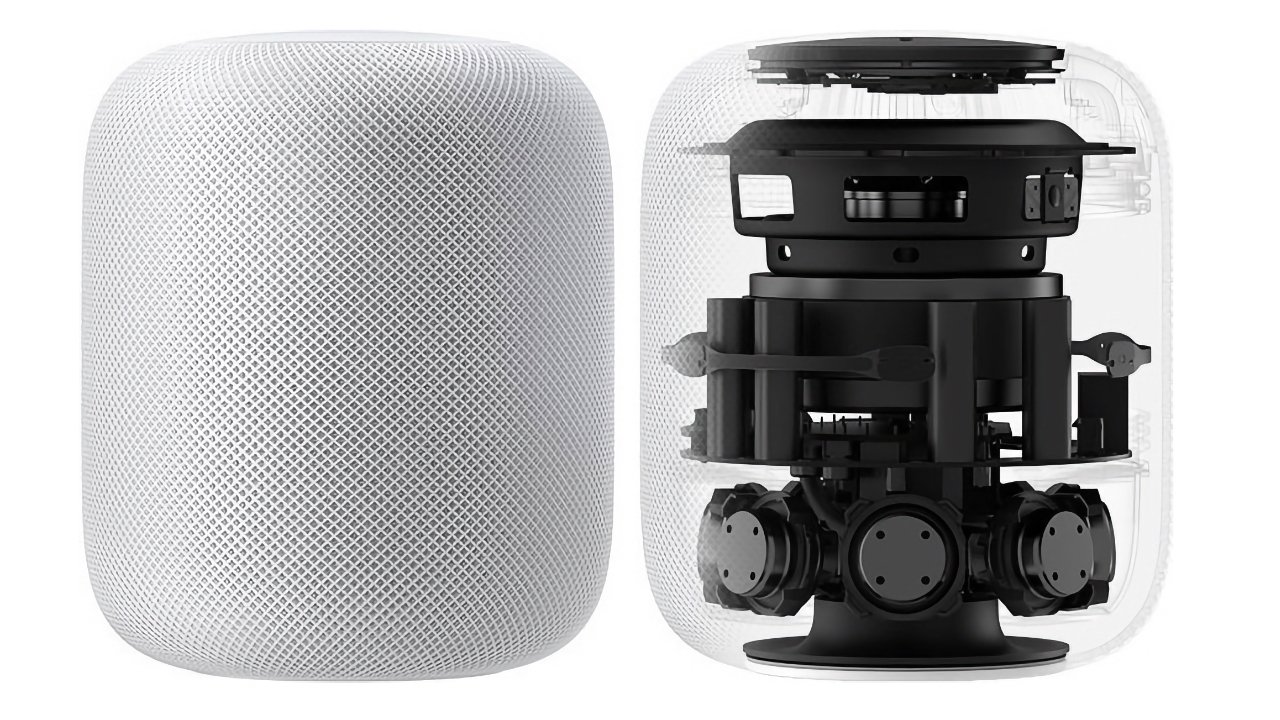
HomePod in 2018
Apple has introduced its own speakers with HomePod and HomePod mini, and continues to develop Apple TV as a standalone product for high quality streaming to any TV. Both also integrate into its HomeKit licensing and AirPlay 2, making it easy to connect smart devices, home cameras and other sensors, and to operate these with Siri voice commands.
Rumors are now swelling that Apple sees potential opportunity in bringing new connected devices for managing the home. And of course, Apple's release last year of Vision Pro is the latest expression of the concept of a productive, creative experience integrated with a digital storefront offering their party apps and access to existing media and new content in new formats, including the emerging space of Immersive Video and interactive AR experiences.The shift to streaming
From its beginnings as an integrated WebObjects store inside iTunes, Apple's Music Store increasingly shifted to new technologies as they became available. As Apple's Mac platform matured and was joined by the mobile iOS as an apps platform, Apple's work to modernize and improve its development tools resulted in regular updates to its iTunes app and the servers running the iTunes Music Store.
In 2011 Apple launched iTunes Match for storing music libraries in the cloud and streaming on demand. iCloud integration made all iTunes purchases available for streaming or download from anywhere. In 2012 Apple introduced iTunes Radio as a streaming option similar to Pandora.
Despite many failed efforts to launch "rental music," notably including Microsoft's failed Zune subscriptions, Spotify was finally catching on a viable streaming alternative to the iTunes world of downloads. Its success came largely from paying artists virtually nothing for streaming rights, eating up sales of iTunes downloads the way file sharing had devoured CD sales.
In 2014, Apple acquired Beats Music as its largest ever purchase at $3 billion. It initially incorporated Beats as a brand for speakers and headphones.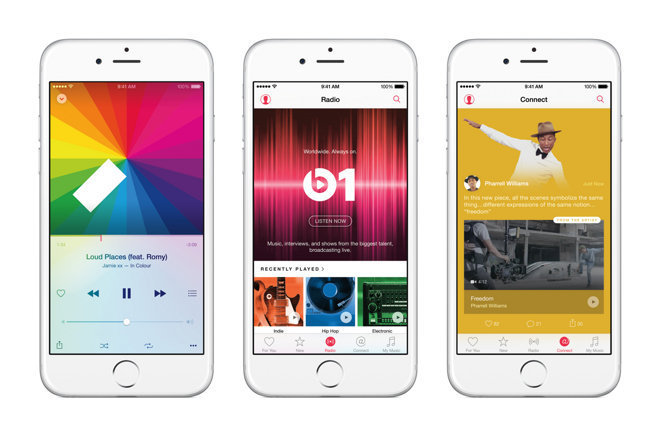
Apple Music in 2015
The next year, it launched Apple Music, using Beats music streaming product, to create a hybrid service of downloads and subscription streaming. It subsequently phased out music purchases and focused on streaming.
In 2017, iTunes ultimately disappeared from iOS and was replaced by standalone apps for Music, TV and Podcasts. In 2019 Apple followed suit on the Mac, replacing iTunes with the same new standalone apps for Music, TV and Podcasts in macOS Catalina. The new apps make use of Apple's latest development tools and are optimized for modern hardware.
As iTunes disappeared to make way for new apps, the iTunes Music Store was replaced by Apple Music, the standalone App Store, and services including Apple TV+ and the new Apple Arcade service of games running across Macs, Apple TV and mobile devices.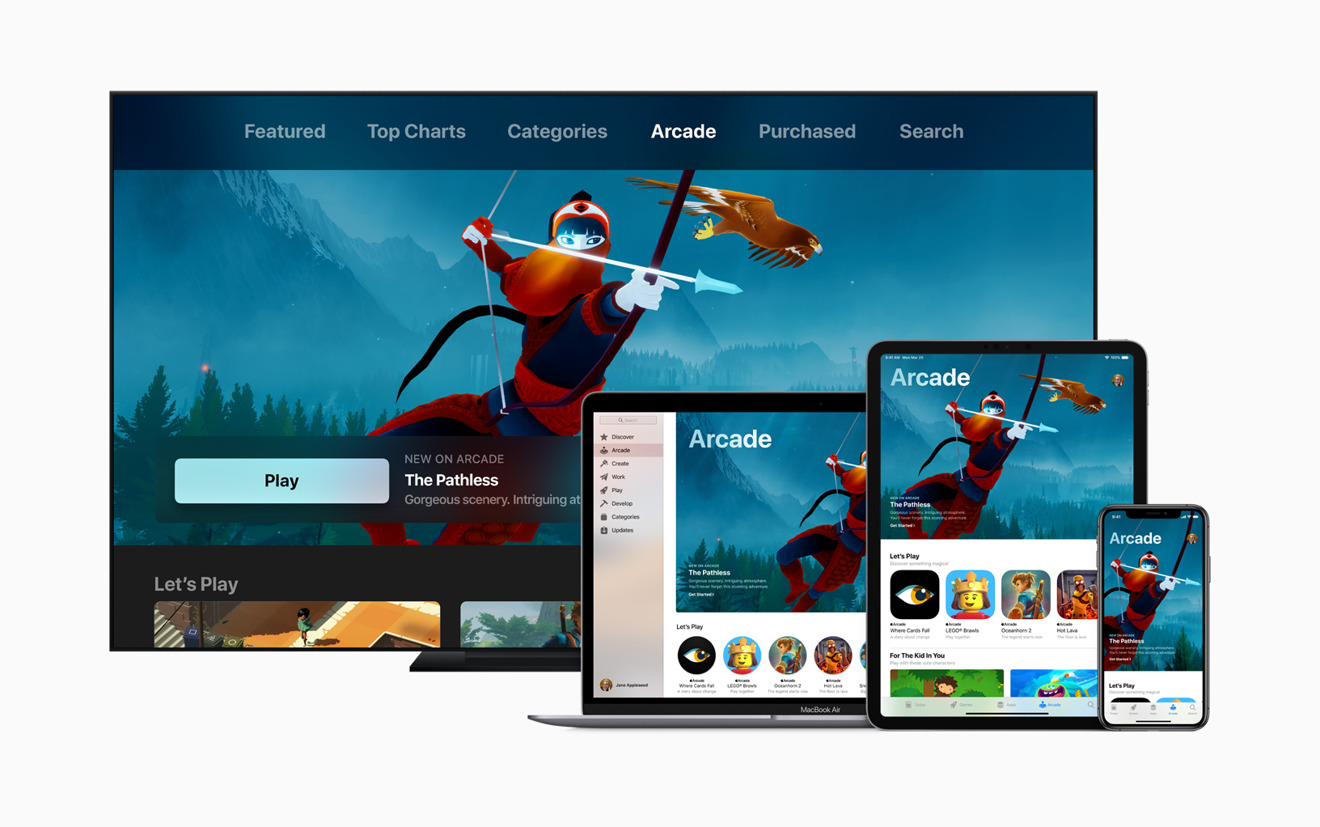
Apple Arcade appeared in 2019
Apple's history of innovation with iTunes and its Music Store continues everywhere it sells and produces digital content. It's extraordinary that Apple developed the most widely known brands in the music industry and then boldly moved away from them to keep pace with the future.
The amount of innovative work Apple put into developing and constantly retuning its efforts in music and media sales is a major reason why it was so successful-- even as others struggled to copy it or best it with alternatives. And we're still not even halfway through the top ten innovations of Apple over the past 25 years!
Read on AppleInsider


-
Apple Invites has Sherlocked party organizing app Partiful
Add another one to Apple's list of third-party apps that it has endangered, as Apple Invites threatens the livelihood of event planning app Partiful.
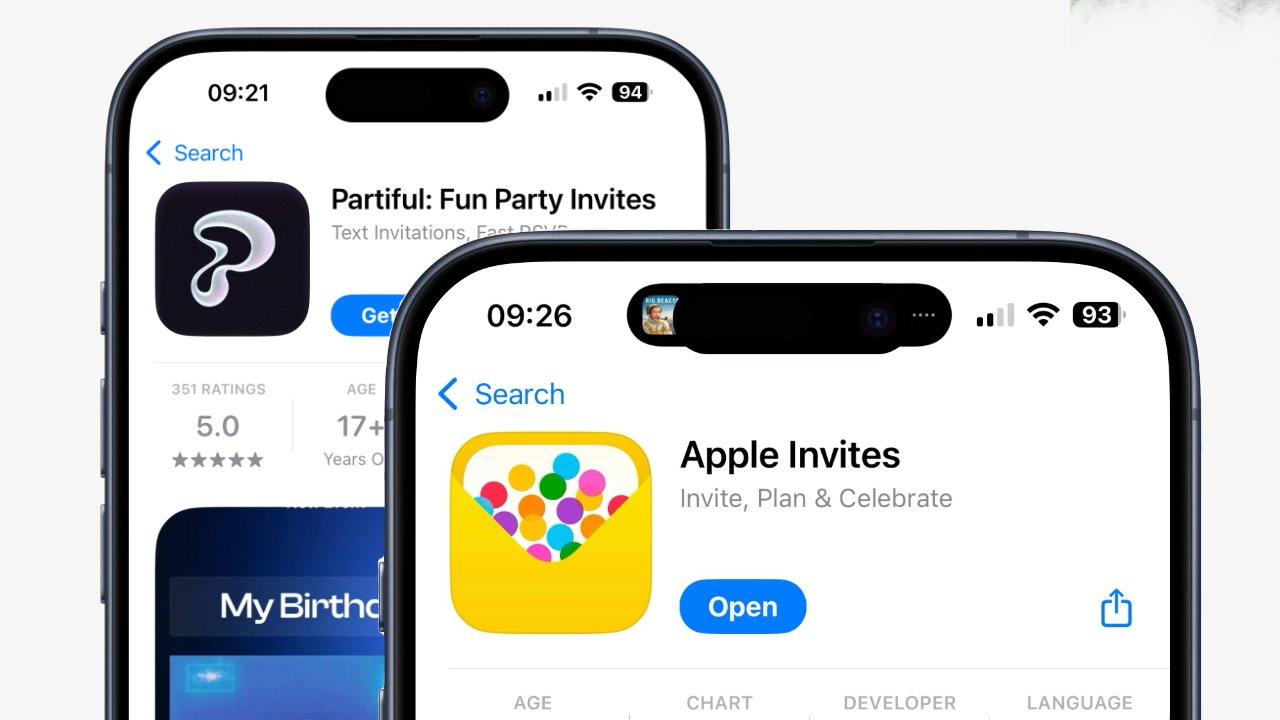
Partiful (rear) and Apple Invites on the App Store
It happens so often that there is a name for it, based on one of the earliest examples of Apple releasing an app or a feature to compete with a third-party rival. Developers know it as Sherlocking, and they know very well that it can be the end of their business.
With a glass half-full kind of view, though, there is a way to argue that Apple producing an app to rival yours will actually grow the market. There is even some logic to that, in two ways.
First, Apple will always promote something just about infinitely more and better than any small developer can. So it will make more people aware of, in this case, party or event planning.
Then it's also true that Apple will only go so far in its apps. Apple apps tend to be very good -- although Apple Invites is a bit shaky -- yet they are never the most powerful option.
Apple Reminders, for instance, is an exceptionally well-made To Do app, but nobody will ever downgrade to it from Things 3, Todoist, or OmniFocus. Apple Calendar is excellent, but there's still a strong market for the much more feature-rich Fantastical.
Partiful isn't as well known by iPhone users as the likes of Fantastical or OmniFocus, but it's also considerably newer than those. While the company was founded as a website in 2020, it wasn't until 2024 that it launched either an iOS or an Android app.
Even so, Partiful's developers have been critical of Apple's launching Apple Invites.just reviewing the apple developer guidelines pic.twitter.com/HohuNn0YoM
-- Partiful (@partiful)
What may make Apple's move more painful is that even if you hadn't noticed Partiful's launch, Apple had. Apple included it as one of its 2024 Cultural Impact Finalists, although it didn't then win.
Still, even before its iOS launch, Partiful was boasting millions of users, according to The Washington Post. So it's a success and now Apple has come along to spoil things.Inevitable development
As with practically all incidents of Apple Sherlocking apps, though, there is a further argument that it was inevitable. It's an argument that goes right back at the start when Apple had a search app actually called Sherlock.
After Apple released Sherlock, a third-party developer created an add-on called Watson, which gave the app more features. Apple did then incorporate those features and that did then kill off Watson, but they were obvious search features that Sherlock would surely have gained anyway.
With Partiful, what Apple has really done is leverage its existing services. Apple Invites uses Apple Maps and Apple Music, plus Messages and Mail, to create and manage events.
It's peculiar that you have to actively tell it to add your event to your calendar, but otherwise Apple Invites is tightly integrated into Apple's services. It makes good use of what Apple users already have and arguably, it's an obvious extension of Apple Calendar.
In fact, it's so obvious an extension of Apple Calendar that there are elements of Apple Invites that compete with Fantastical's scheduling features. It's just also so obvious an extension of Calendar that it should be in that app.
As a standalone event app, Apple Invites is a clearer competitor to Partiful. Apple can't touch that app for its Android version, or at least it hasn't tried, and its reported millions of users are likely to stick with Partiful for its features and familiarity.
But there will unquestionably be users who might have tried Partiful, who now won't. And that's the kind of Sherlocking that gives Apple a bad reputation in this space.Mid-cycle Sherlocking
One surprise about Partiful being Sherlocked by Apple Invites is the timing of it. While it announced its Apple Sports app, which at least tries to Sherlock some other sports apps, in February 2024, it usually waits until WWDC in June.
So Journal was announced at WWDC 2023 and clearly Sherlocked Day One. Password managers such as 1Password and LastPass saw Apple muscling in with Passwords after WWDC 2024.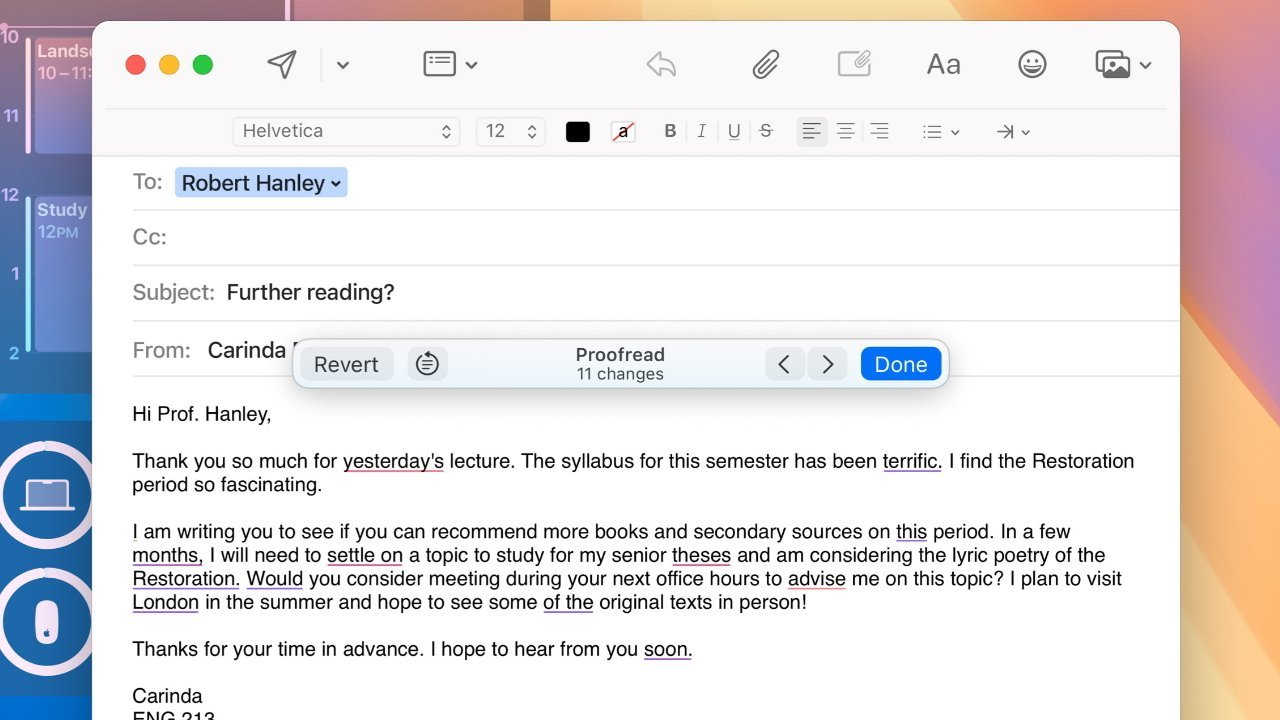
Apple Intelligence's Writing Tools arguably Sherlock Grammarly
LastPass, 1Password and even Day One have continued and appear to have held on to customers. But even amongst AppleInsider staff, Grammarly has taken a beating with Apple Intelligence's Writing Tools from WWDC 2024.
There was no possibility, though, that Apple Intelligence would not feature Writing Tools. As far as AI and LLMs go, grammar-checking is particularly low-hanging fruit.
So you can argue that Apple is just pursuing the inevitable evolution of its apps and OS.
But what you probably can't argue is that it's going to continue doing Sherlocking developers.
Read on AppleInsider


-
How the new Apple Invites app works, and when you want to use it
While the new Apple Invites app and service sounds easy to use, it joins together so many Apple Services that it takes several steps -- and can confuse your invitees. Here's how to use it.
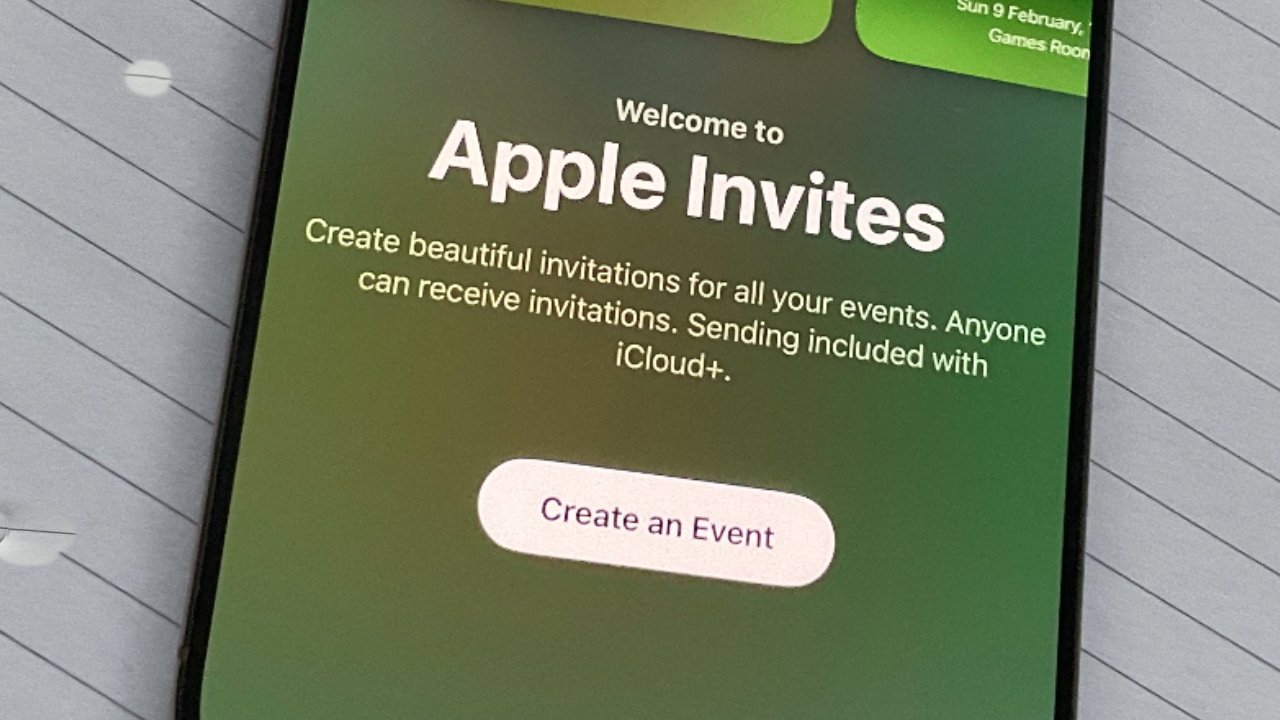
How to use Apple Invites
Apple Invites has been launched, though at time of writing it's still not rolled out worldwide. If an App Store search does not turn it up for you, try this direct link.
The app is so new that there is no Apple support documentation for it, which means there are certain points that are not yet clear. Specifically, it's not sure what Android users will or will not see when they have accepted an invitation from Apple Invites.
Apple Invites is a free iPhone app, but as the organizer of an event, you have to have a paid iCloud+ subscription in order to use it. Your invitees do not, and they do not have to have an Apple Account, so Android users should be able to sign up to your event.
Whether your invitees are iPhone or Android though, what they see can be confusing. Ultimately, you are sending them a link, via Messages or email, and they get that plus a poster image -- if you have chosen one.
You really must include some explanatory text, not least because of what happens next. When they tap on the link or the poster in Messages, they are taken to icloud.com in Safari and -- if they are iPhone users -- they are prompted to sign in.
There is a small X to close that sign in pane, but they'll have to look for it. It would be much better if Apple presented a bespoke sign-in making it clear that this is optional.
As well as using the standard iCloud sign-in form, Apple is also using the standard prompt for getting an app. So at the top of the screen you see an app you might not want, and in the middle you see a sign-in screen that you may be suspicious of.
Apple could also just point out that if you scroll down the webpage, you get the option to join the party with an email address instead of using the app. But then it should know the email address the invitation was sent to, so it's not clear why it doesn't just populate that email field so that you can simply tap yes or no.Setting up is easy for the organizer
That all said, creating an event itself, prior to sending out the invitation, is straightforward -- if at times slow. To create your first-ever event:- Open Apple Invites
- Tap Create Event
- Optionally pick a photo of yours, choose from suggested backgrounds, or skip Add Background
- Type in the event title
- Enter the date and time
- Enter the location
- Write a description of up to 1,000 characters
- Optionally create a shared photo album for the event
- Optionally create a shared Apple Music playlist
- Tap Preview at top right to see how the invitation will look to your recipients
- Tap Next
- Choose how to invite people, and whether to accept them all or approve each one
There's good and bad in these steps. The best is perhaps the date and location picking, because those are well done.
Location is via an Apple Maps style search field. And with date, you get options to include an end time as well as a start.
Creating a shared photo album is straightforward too, but the shared Apple Music one requires an extra step -- and can prove to be slow.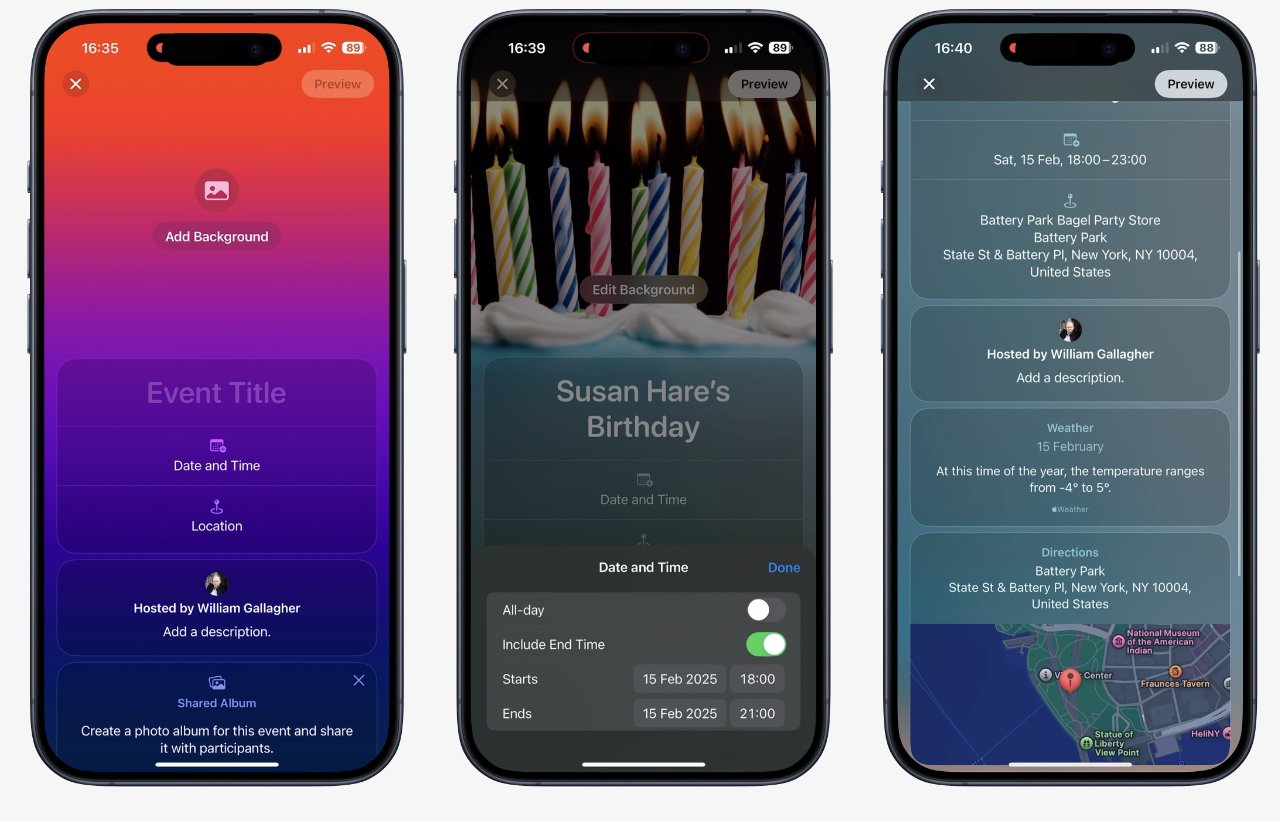
L-R starting to set up a new event
You can't share a playlist unless you have an Apple Music Profile. You may think you have one, since you're an Apple Music subscriber but no, this is different.
An Apple Music Profile tells people that you're up for sharing some or all of your playlists, and that for some unfathomable reason you're interested in theirs. To set up this profile:- Open Apple Music on iPhone
- Tap your icon (possibly just your initials) at top right on the Apple Music Home screen
- Choose Set up Profile
- Fill out a username
- Tap Continue to Find Contacts
- Click Follow if you want to follow a friend's playlists, then Next
- Choose whether you can be followed by Everyone or only People You Approve and tap Next
- Pick which, if any, of your playlists you're happy to share and tap Done
If you're not already regretting that you wanted a shared playlist for your event, you may do now. Because in AppleInsider testing, Apple Music hung at this point and had to be force quit.
Ignoring that and going back to Apple Invites, you are next prompted to decide "How do you want to share contacts?" -- and this is again not clear.
The reasoning is that people you invite to an event may need to contact each other, but Apple will never give out any private details. You have to make that decision, you have to decide what you want to do -- and it appears that you cannot choose that you don't want to share anything.
It appears that you have to choose between allowing your invitees to see selected contacts that you will specify in a next step, or all of your contacts. In practice, Apple does only allow these two options at this point, but after you've decided on just Select Contacts, you can skip in fact adding any.
Optionally and slowly adding Apple Music before sending an invitation
You don't appear to be able to say that you will only share, say, email addresses, and keep phone numbers or photos private.Finally sending the invitation
After you've gone through fathoming out how happy you are to share people's contact details, you finally get a Choose a Guest option. Here there are two sorts of guests, either someone you allowed in the contact-sharing stage, or New Guest.
If you now tap on the name of the contact you previously allowed, you're now given the ability to send them a unique invitation link. You can send it via Messages, Mail, or copy the link to send around any other way you like.
Depending on your choice, you now have to pick which phone number to text, or which email address to send to if the recipient has more than one.
The Message or email is shown to you as solely a link, specifically an iCloud link. You can enter some explanatory text, and you should.After the invitation is sent
Once you've done all of this and sent the invitation, and once the recipient has figured out that you haven't sent them a spam link, they can elect to join your little group. They can tap a Going, Not Going, or Maybe button, and be reminded of how Facebook does it the same way.
When they have made their choice, you are notified as the event organizer.
This is where the real benefit of Apple Invites will come. You could always have sent out invitations by Messages yourself, but managing the replies would have been hard.
Apple Invites lets you see at a glance who has said they're coming. They may still not turn up, you know what people are like, but at least you will have an idea of numbers.
And any of those people who are coming will, at least if they are iPhone users with the Apple Invites app, be able to contribute photos and music to the party.A mish-mash of services
So far in setting up a first event, Apple Invites has leveraged Apple Maps, Apple Music, Photos, Contacts, and Messages and/or Mail. Much of this has required entering or confirming permissions, turning a simple procedure into a chore.
But then there is one more Apple service that can optionally be used -- and it's the one solitary service you would think would be automatic.
Calendar.
You go through this whole process and nothing at all ends up in your Calendar, or at least not automatically. You're not even prompted to add the event to your Calendar as you're making or editing it.
Instead, you have to choose to go find and tap the Calendar icon at top right of the invitation to create an event.
And of course the first thing it does is ask permission for Apple Invites to access the calendar.
All of this does take far less time to do than to describe, and overall it is a clever way of benefitting from there being so many Apple services. But each step does feel like a barrier, when you're setting up your first event.
The second and subsequent events get to skip certain steps. For some reason, there isn't the same confusing going through of contacts to share, for instance.
Instead, you get the option to create a general link you send to anyone, or you can choose a specific guest.
Except by default, that specific guest can only be one you allowed contact details to be shared for. Tap on Choose a Guest and you are offered their name or names, and a Settings button for you to add more.
So Apple Invites definitely looks good, it does definitely offer a good service in how it manages RSVPs. But there are enough rough edges that maybe it should have gone through in-house user testing as was expected.
Read on AppleInsider

